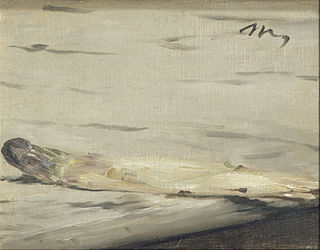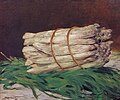The asparagus (Manet)
The asparagus , also a single asparagus or asparagus , ( French L'asperge ) is a still life by Édouard Manet, painted in oil on canvas in 1880 . It has a height of 16.5 cm and a width of 21.5 cm. The picture, painted in the style of Impressionism, shows a single asparagus spear on a marble slab. Manet painted the picture as a gift to his friend Charles Ephrussi . It belongs to the collection of the Musée d'Orsay in Paris .
Image description
The picture shows a single asparagus spear on a marble slab. The marble top, part of a table or the end of a sideboard , takes up almost the entire canvas. An edge runs diagonally from the lower left corner to the right edge of the picture. Below, in the right corner, the picture is painted in dark brown tones. This could be the wooden substructure of a sideboard or the shadow area of a table. The marble top is painted in white-gray. There are some lively, vertical brushstrokes in dark gray that suggest a marble structure. The signature “M” for Manet can be found in the marble surface at the top right.
The asparagus spear lies parallel to the lower edge of the picture, almost horizontally on the marble surface, with the head slightly curved upwards. While the head of the rod almost touches the left edge of the picture, the other end extends over the inclined edge of the table to the right edge of the picture and is partially cut off from it. The asparagus spear lies largely on the marble slab, while the tip of the head and part of the lower end float in the air. The asparagus spear is rich in color. In the middle there are white and yellow tones, at the lower end there are individual spots in brown. At the head of the asparagus there is an application of white, light brown, dark brown, yellow, light green, dark green, blue, purple, violet and light red. With the clearly recognizable individual brushstrokes and dabs of color, Manet shows his impressionistic painting style. A few shadows under the two ends of the asparagus spear suggest a light source above the picture.
The art historian Manuela B. Mena Marqués emphasized that with the simplicity of the subject, Manet had succeeded in painting nature, light and color to perfection. It was a difficult task to paint the yellow and white vegetables on a table with almost the same color. The museum director Françoise Cachin pointed out the successful lightness of the picture and added “... with the light background, with the delicate play of blue and gray between the asparagus spear and marble slab and a few lively dabs of color on the asparagus tip, Manet is totally different casual painting. At the same time he demonstrates his enormous craftsmanship ... ". This was underlined by the French philosopher Georges Bataille : "Manet's wonderful still lifes are ... far removed from the decorative". The picture of the asparagus "... illuminates the slide of things into the world of indifference." For Bataille, the asparagus is " nature morte , but still nature, so cheerful life."
To the creation of the picture
The banker and art collector Charles Ephrussi visited Manet in his studio in 1880 and saw the just completed still life Bundle of Asparagus ( Wallraf-Richartz-Museum & Fondation Corboud , Cologne). This painting shows a bunch of asparagus on a table against a dark background - a motif known from Dutch baroque painting. Manet named a purchase price of 800 francs and Ephrussi bought the picture. Instead of the required amount, however, Ephrussi sent the painter 1,000 francs. Thereupon Manet painted the much smaller picture The Asparagus and sent it to Ephrussi with the message “Il en manquait une à votre botte” (“There is still one missing in your bundle”). Manet's gift to Ephrussi differed not only in format and motif, but above all in color and painting style from the bundle of asparagus he had bought . The clearly lighter picture of the asparagus shows a much freer painting style.
In the 1860s, Manet created several still lifes in which he put various objects together in an arrangement and thus linked to traditional still life painting. For example, his painting The Salmon ( Shelburne Museum , Shelburne) shows, in addition to the eponymous fish, which lies on a plate in the center of the picture, other objects such as two bottles, a glass, a bowl, a salt barrel, lemons and cutlery. Towards the end of his life, from 1880, he reduced the number of objects in his still lifes until he finally created pictures with only one object. He painted pictures such as the lemon ( Musée d'Orsay , Paris) or apple on a plate (private collection). Françoise Cachin described Manet's representations of individual objects as "extracts, quintessences of painting".
Provenance
Manet gave the picture to Charles Ephrussi in 1880. After his death, it was bought by the Bernheim-Jeune art dealer and subsequently moved to the private collection of Gaston Bernheim-Jeune. In 1951, the New York-based art dealer and collector Sam Salz bought the painting. He donated the painting to the Musée du Louvre in 1959 . From 1959 to 1986 the picture was shown in the Galerie du Jeu de Paume . It has been part of the Musée d'Orsay collection since 1986 . The two paintings The Asparagus and The Asparagus Bundle were rarely exhibited together after Ephrussi's death in 1905. These include the Manet exhibitions in Charlottenlund in 1989 and in Madrid in 2003/4 . Most recently, both pictures were combined in exhibitions in 2017–2018 in Washington, DC and in 2019 in Chicago.
literature
- Georges Bataille : Manet . Skira, Geneva 1988, ISBN 3-8030-3111-7 .
- Françoise Cachin , Charles S. Moffett, Juliet Wilson-Bareau: Manet . Exhibition catalog, German edition: Frölich and Kaufmann, Berlin 1984, ISBN 3-88725-092-3 .
- Stéphane Guégan: Manet, inventeur du moderne . Gallimard, Paris 2011, ISBN 978-2-07-013323-9 .
- Hans Körner: Edouard Manet, dandy, flaneur, painter . Fink, Munich 1996, ISBN 3-7705-2931-6 .
- Manuela B. Mena Marqués: Manet en el Prado . Exhibition catalog, Madrid 2003, ISBN 84-8480-053-9 .
- Gert von der Osten : Manet, dedicated by the Wallraf-Richartz Board of Trustees to the willing donors to acquire Edouard Manet's still life for the Wallraf-Richartz Museum in Cologne . Combination of two articles from the Wallraf-Richartz-Jahrbuch Volume XXXI 1969 and Volume XXXIII 1971, Wallraf-Richartz Museum, Cologne.
- Eliza E. Rathbone (Ed.): Renoir and friends: Luncheon of the boating party . Exhibition catalog The Phillips Collection, Washington, DC 2017, ISBN 978-1-911282-00-6
- Allan Scott, Emily A. Beeny, Gloria Lynn Groom (Eds.): Manet and modern beauty: the artist's last years . Exhibition catalog Art Institute of Chicago and J. Paul Getty Museum, The J. Paul Getty Museum, Los Angeles 2019, ISBN 978-1-60606-604-1 .
Web links
Individual evidence
- ↑ The following titles can be found in the literature: The asparagus in Georges Bataille: Manet , p. 96; A single asparagus in Gert van der Osten: Manet , p. 21 and asparagus in Françoise Cachin, Charles S. Moffett, Juliet Wilson-Bareau: Manet , p. 451.
- ↑ L'asperge is given as a name on the website of the Musée d'Orsay, see web links
- ↑ Hans Körner: Edouard Manet , p. 202.
- ↑ Manuela B. Mena Marqués: Manet en el Prado , p. 485.
- ^ A b Françoise Cachin, Charles S. Moffett, Juliet Wilson-Bareau: Manet , p. 451.
- ↑ Georges Bataille: Manet , p. 96
- ↑ Georges Bataille: Manet , p. 98
- ^ Georges Bataille: Manet , p. 118
- ^ Gert van der Osten: Manet , p. 9.
- ^ Mikael Wivel: Manet , p. 140.
- ↑ Manuela B. Mena Marqués: Manet en el Prado , p. 323.
- ↑ Eliza E. Rathbone: Renoir and friends, Luncheon of the boating party , pp. 95 and 133.
- ↑ The Cologne asparagus picture was only awarded for the exhibition in Chicago. See Allan Scott, Emily A. Beeny, Gloria Lynn Groom: Manet and modern beauty: the artist's last years , p. 291.




